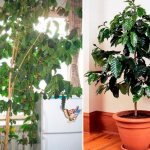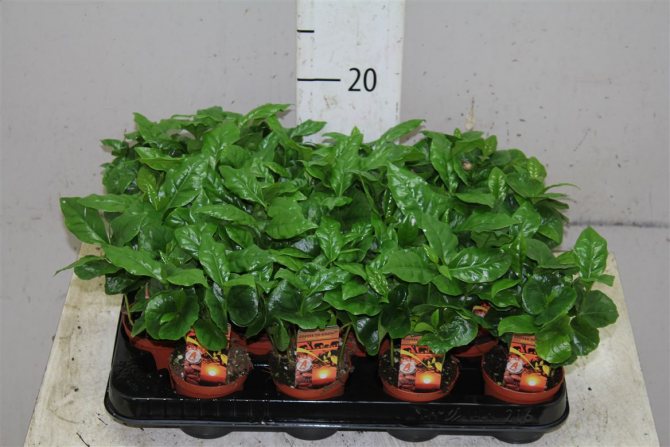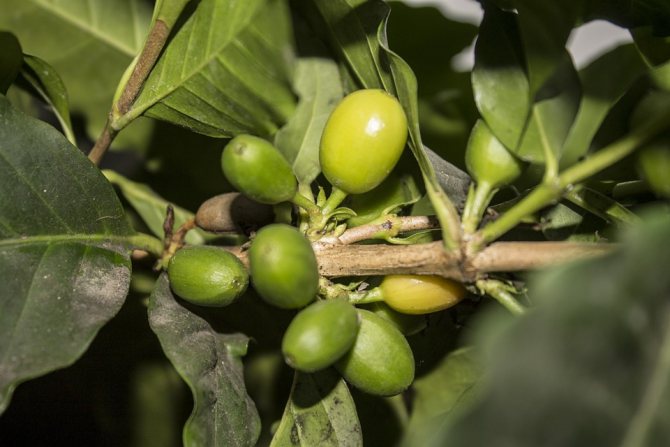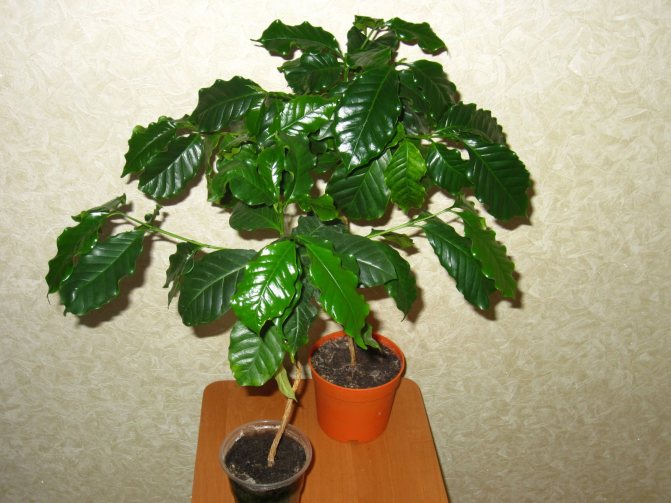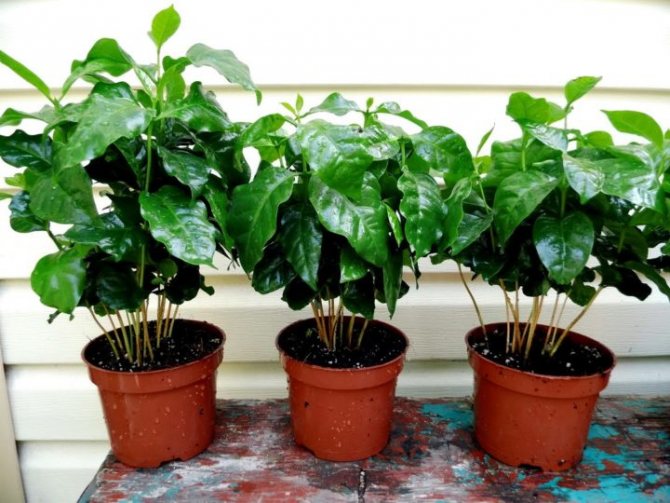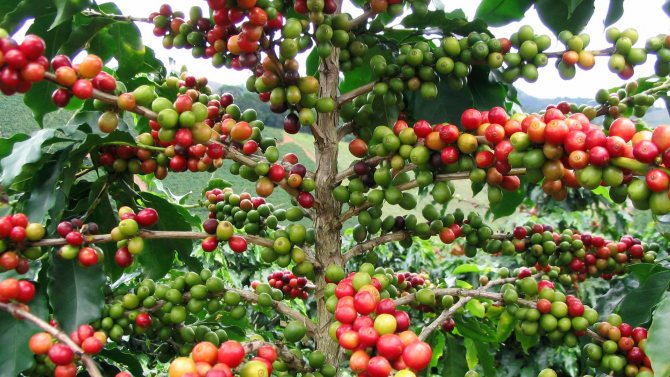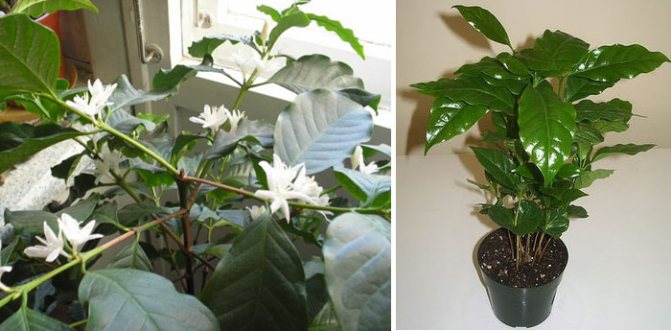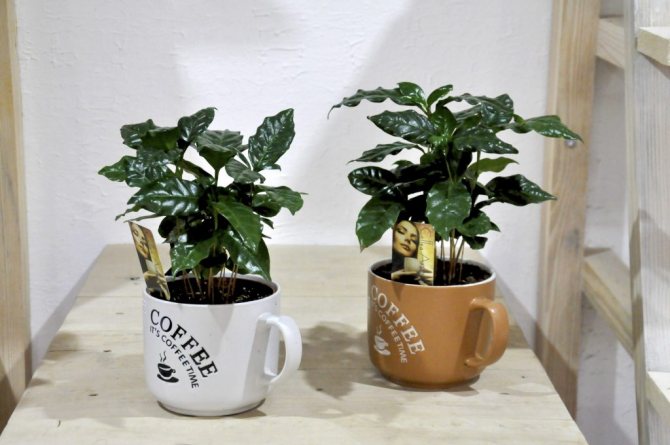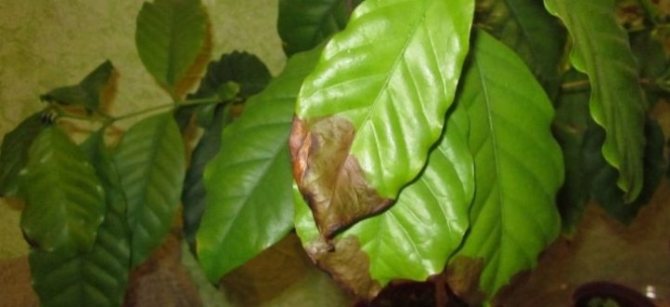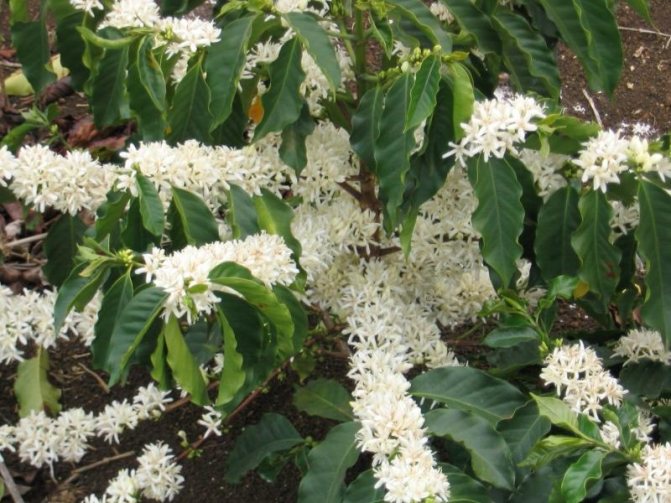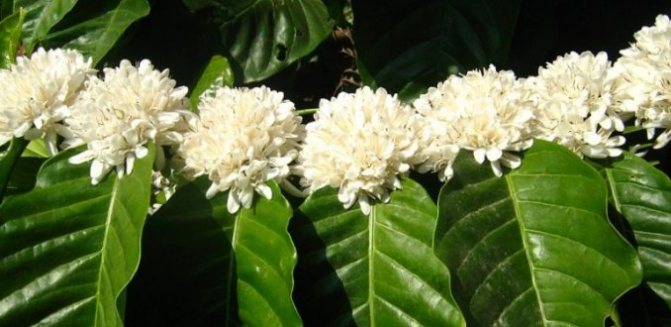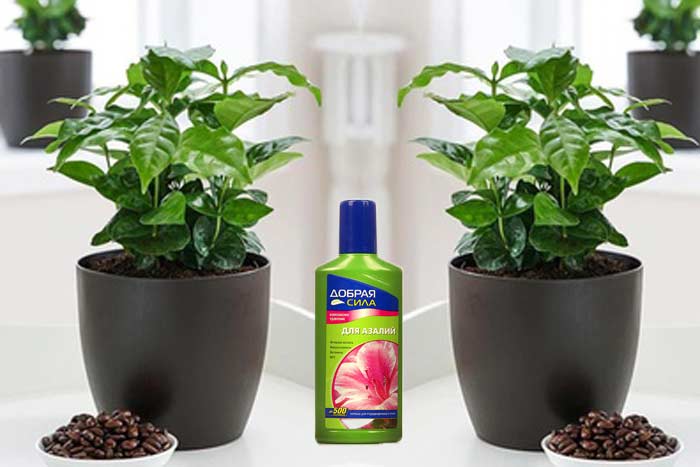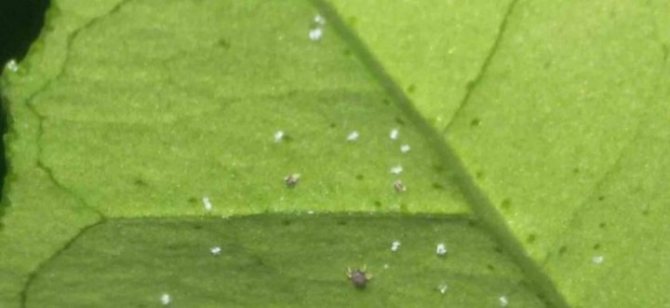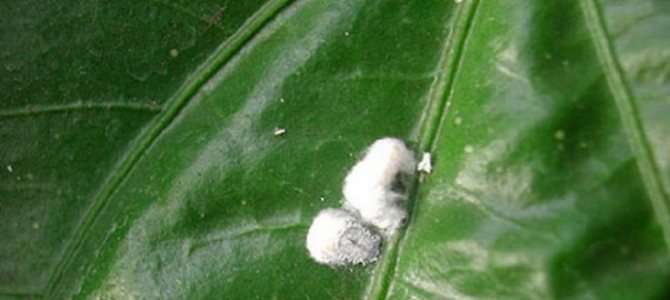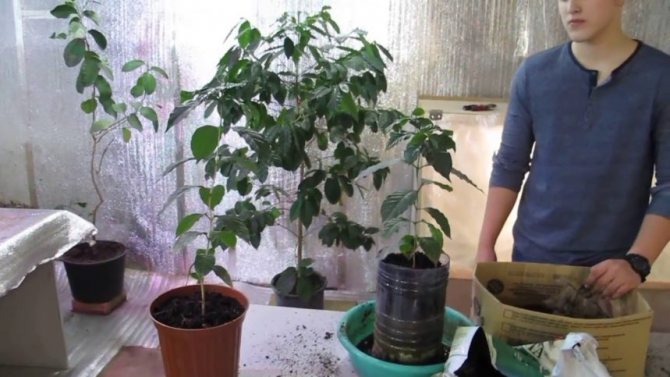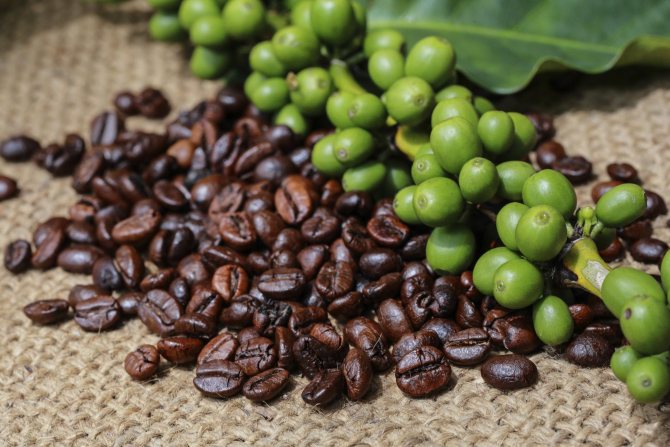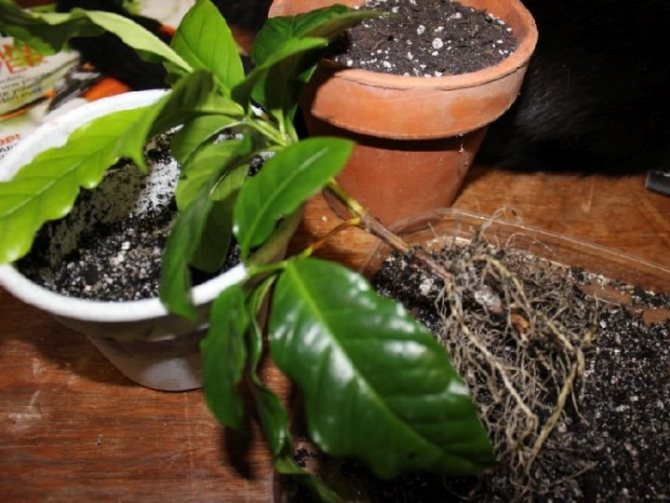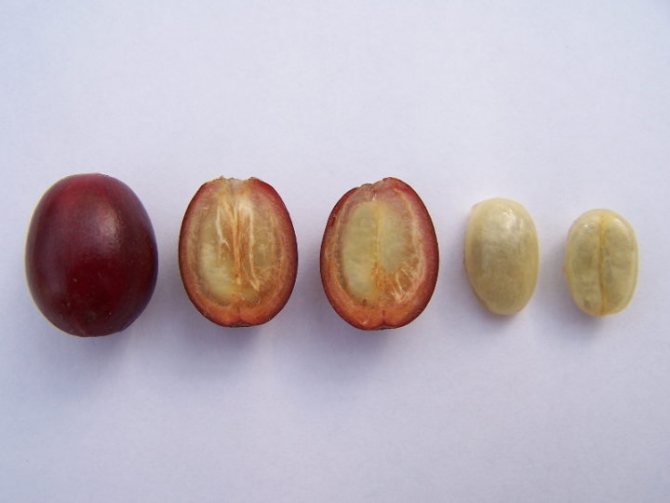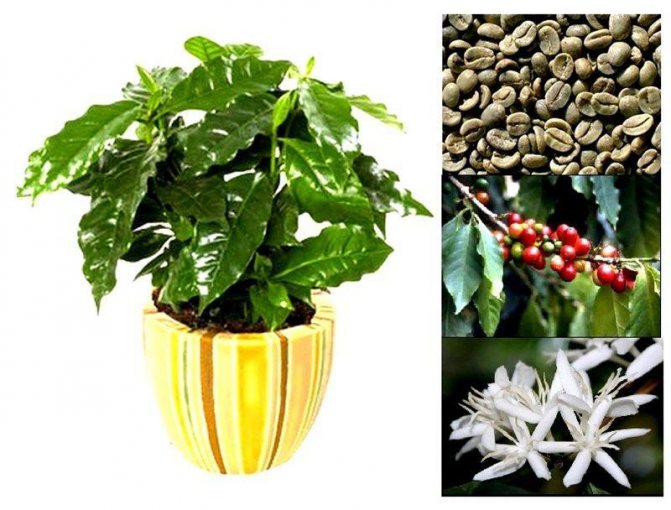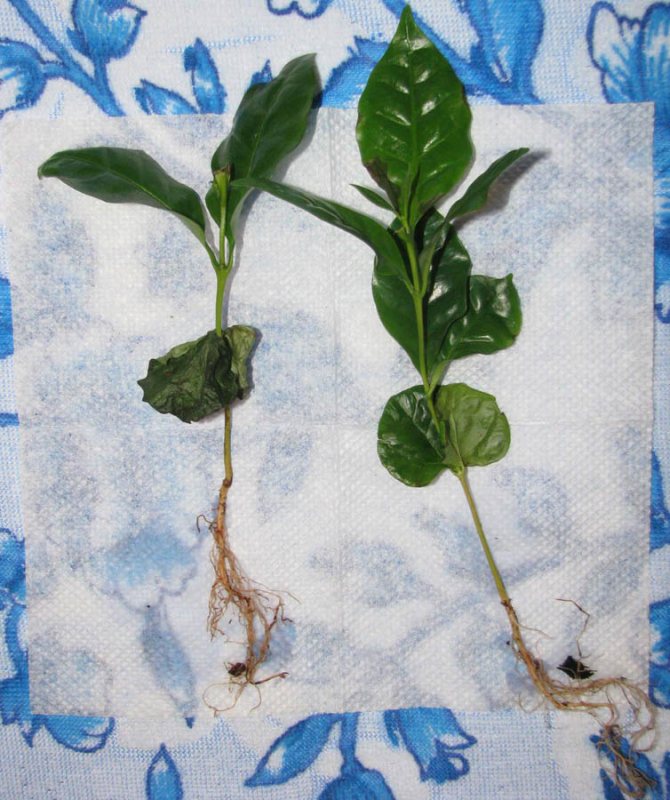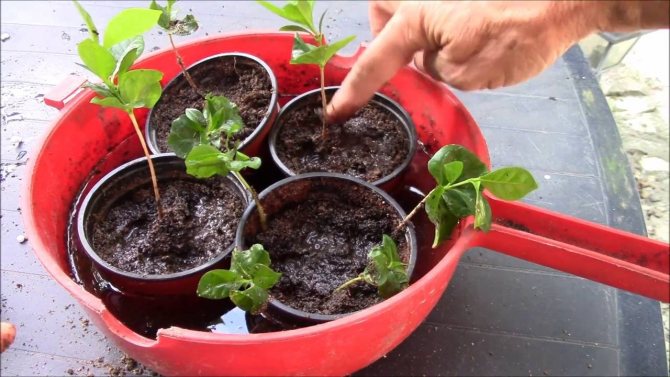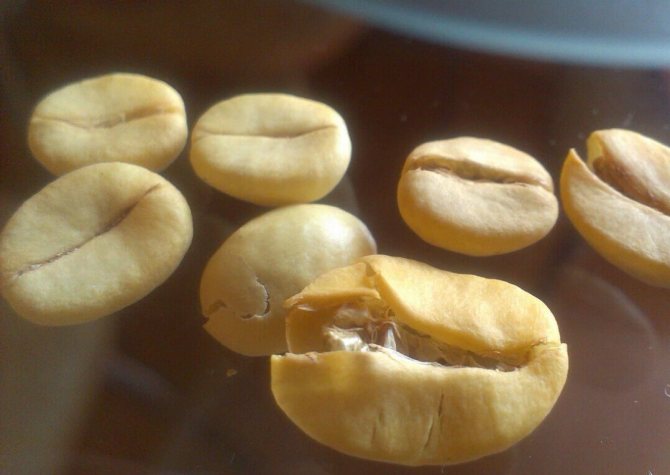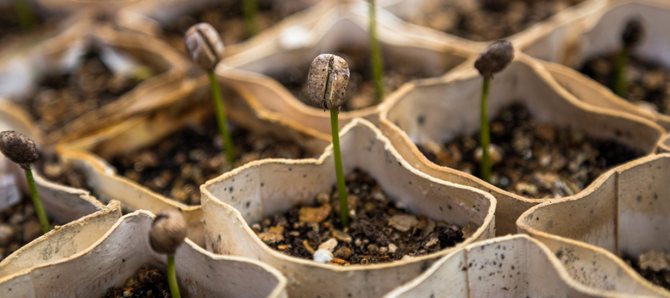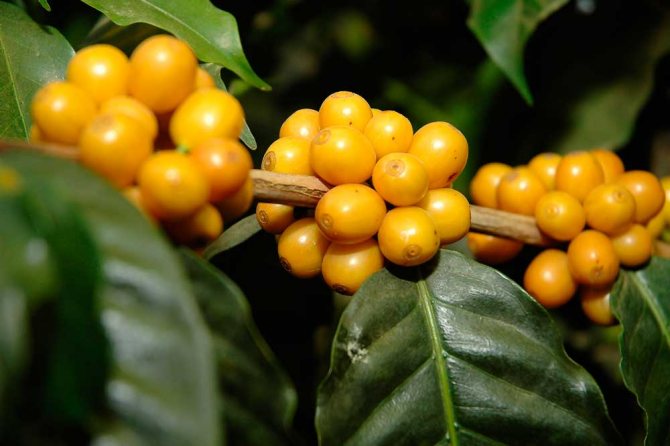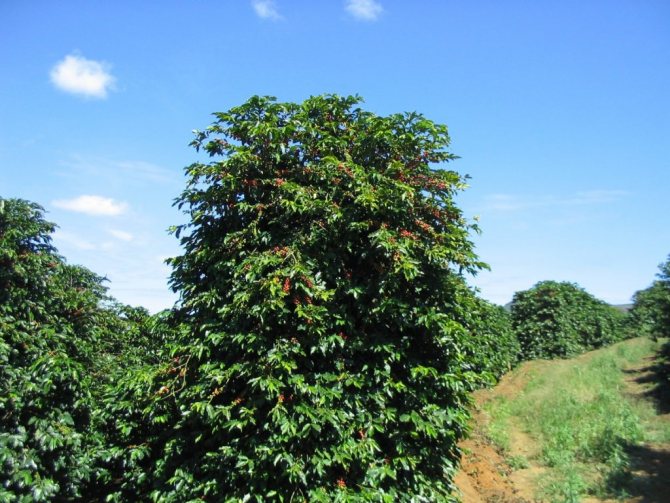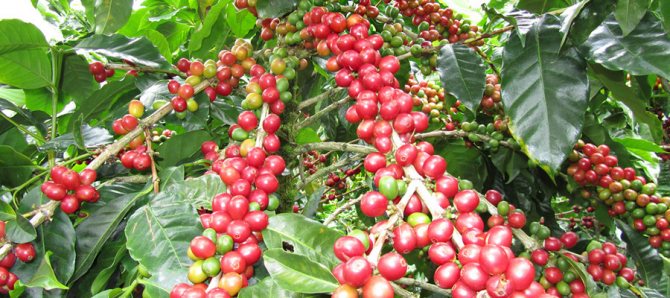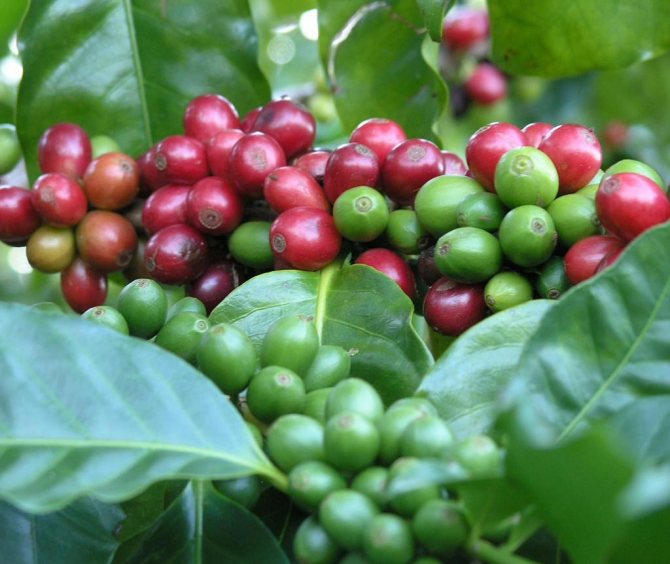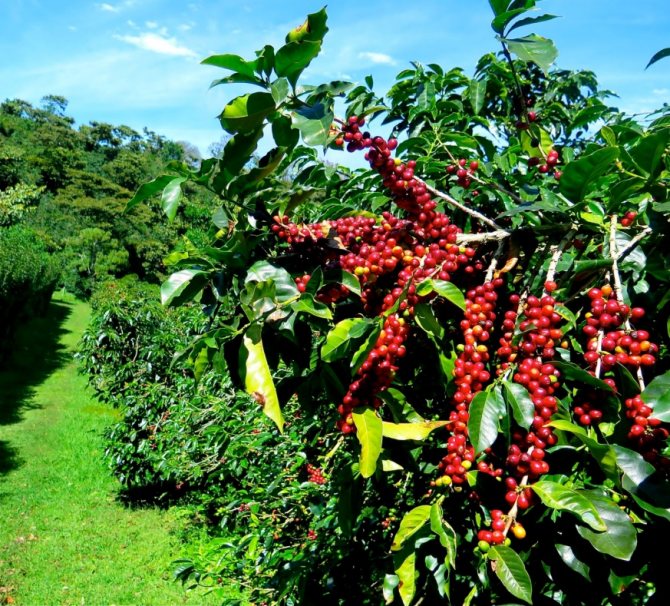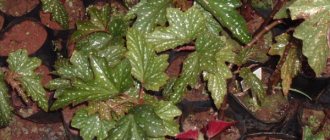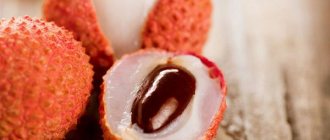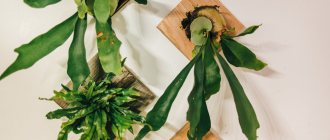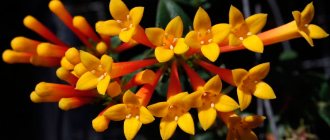Many amateur flower growers dream of having a coffee tree in their collection. Some of them believe that only specialists can cultivate it. However, this is a delusion. Arabica coffee is a houseplant that can be grown at home on a windowsill if the plant is properly cared for.
Arabica coffee is a perennial shrub or small tree from the Marenov family. Its homeland is Africa or Asia, now it is grown in many countries of the world.
The flower is distinguished by dense bright green shiny foliage. The leaf plates are sharp at the ends, with well-defined veins. Branches-trunks are slender, thin and at the same time very flexible. They can reach a height of 15 cm.
But most of all, the coffee plant is loved for its flowers, which look like small stars, very reminiscent of jasmine flowers. These petals, white with an incredibly pleasant aroma, can be seen in the spring when the buds are in full bloom.
They bloom for only a couple of days. And after 6 months, fruits of red or black color appear on this place. In their shape, they resemble cherries, but they are oblong in shape. Each such "cherry" forms two coffee beans. It is they who delight coffee lovers in the morning.
Temperature
Although the coffee tree grows in the tropics, it cannot stand the heat and scorching sun rays. If the plant is too hot, it will not bloom. The tree should be placed in a well-lit place, but so that direct sunlight does not fall on it. If the window in the room faces south, then the flowerpot should be at a distance of about 1.5 m from the glass.
Optimal room temperature for wood:
- in the warm season - from +23 to +25 ° C;
- in winter - +17 ° C, in extreme cases - not lower than +15 ° C.
When caring for a coffee tree, it must be borne in mind that it does not tolerate a change in orientation in space. Experts do not recommend turning the flowerpot more often than once every 5 years, otherwise the plant will drop flowers. To keep the crown symmetrical, you can put a mirror next to the coffee tree (but so that direct sunlight is not reflected).
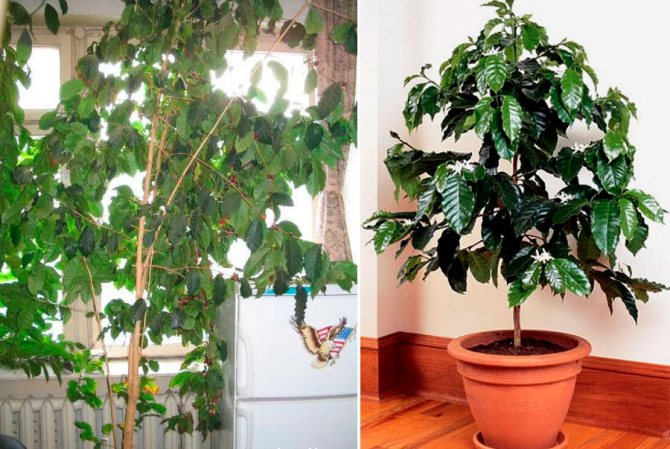
Caring for a Arabica coffee flower at home
Caring for a coffee tree at home involves observing the temperature regime, proper watering, and maintaining the required level of light and humidity. In addition, it is necessary to constantly feed the plant and make sure that there are no pests.
Location and lighting
An African guest will love the very bright side of the apartment, but without direct sunlight. An east or west window would be ideal. In the warm season, the coffee bush can be taken out on the balcony, sheltering it from the sun and precipitation.
Note!
However, experts recommend not to disturb the flower unnecessarily. He does not like a change of residence, and an extra rearrangement can affect the appearance of fruits. For the same reason, you should not cut the flower. And one more secret: coffee is a loner plant. He doesn't like neighbors. Therefore, it is worth highlighting a separate window sill for it.
Temperature
In winter, it is important to monitor the air temperature. It should not fall below 15 ° C. Coffee doesn't like cold weather.Drafts and sudden changes in temperature, as well as too dry air, have a bad effect on the flower. All this can destroy the plant.


You may be interested in:
Ranunculus: planting and care in the open field, photo A beautiful flower of ranculus can be grown both in the garden and on the windowsill. Such a flower picks up everything ... Read more ...
Watering and humidity
High humidity is contraindicated for the flower. Because of it, various pests can appear. For them, it is a rewarding environment. Very dry air is also dangerous. Humidity should not be lower than 40%. You need to spray the plant only if it is very hot and there is no way to take it to the balcony. In winter and in hot weather, you can use an electric humidifier. The main sign of dry indoor air is the yellowed tips of the coffee leaves.
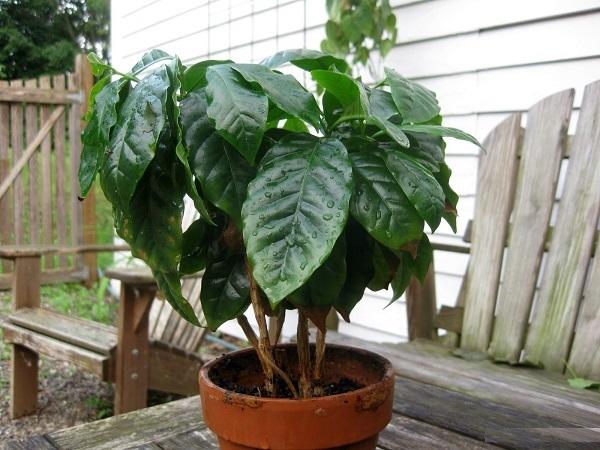

Arabica coffee is fussy and watering. Do not use tap water for irrigation. It contains a lot of chlorine, lime and all kinds of impurities that can harm the roots. It is best to take settled water. And for the water to be beneficial, you can add a few drops of lemon juice or vinegar to it. This is necessary for the normal acidity of the soil. There is no need to fill the flower - he does not like it.
It is very important to monitor the condition of the soil. If it's too wet, the plant will fade and start shedding leaves. Harmful to coffee and excessive dryness. Therefore, it is better to water the flower little by little, but more often.
Top dressing
Top dressing plays an important role in proper coffee care. It is necessary for the flower to grow strong and healthy. Experts recommend using liquid mineral fertilizers containing phosphorus, potassium and nitrogen. You can also replace them with natural bone meal or horn shavings in a ratio of 200 g per 10 kg of soil.
It is best to feed coffee during the period of active growth, at least once every six weeks. It is necessary to do this in different periods of its development. So, with the appearance of buds, a large amount of nitrogen and phosphorus is needed, which is needed for the ripening of fruits. During flowering, a complex of minerals is best suited. It will not be superfluous to determine the PH of the soil for the correct selection of the necessary nutrition. You can do this at a flower shop.
Diseases and pests
Like any other plant, coffee can be attacked by pests and get sick. A monthly warm shower is very beneficial for the plant. This must be done carefully, trying to prevent water from entering the pot. All this will not only make the leaves shiny and beautiful, but also help prevent the appearance of spider mites. This is the main pest that can appear on plants. The main signs of a spider mite are a small cobweb, as well as light spots on the leaves.
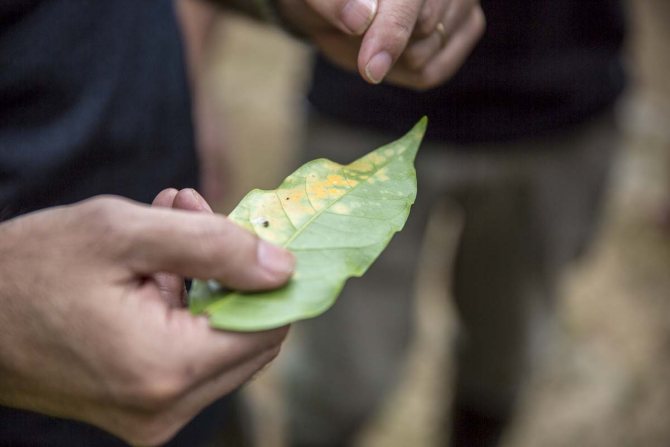

Coffee tree disease
Often the plant is harmed by scale insects and aphids. To combat these parasites, first of all, you need to treat the damaged leaves with soapy water, and then you can use store-bought preparations. The most popular are "Karbofos" or "Actellik" 0.15%. They are diluted in a ratio of 10 drops per half liter of water. More than one spraying may be needed at intervals of several days. Regular alcohol will also help get rid of aphids.
The fungus can kill the plant. It is easily recognizable by its reddish spots that resemble rust. Getting rid of it is quite difficult. Bordeaux liquid, copper sulfate or antifungal preparations for indoor plants will help. But all this can be applied only after reading the instructions.


You may be interested in:
Perennial flowers for a flower bed, blooming all summer: undersized Along with annual flowers in a flower bed, summer residents always try to plant perennial flowers, and sometimes only ... Read more ...
Arabica coffee can also suffer from bacterial or viral infections.At the same time, yellowed leaves and trunk are the main signs of damage. To get rid of them, it is necessary to treat the coffee with a solution of potassium permanganate or copper sulfate, removing the damaged areas.
In addition, due to improper care, non-compliance with the temperature and humidity level, the leaves of the plant can turn black, yellow and dry. For the same reason, and due to improperly selected soil, the flower may not bloom.
Watering
The coffee tree loves moisture, but if the water stagnates in the flowerpot, the roots will rot. Therefore, it is impossible to fill the plant, and drainage must be laid on the bottom of the pot. If the tree does not have enough water, the leaves drop, become lethargic, but rise very quickly after watering.
Watering frequency depends on temperature and humidity. So that the plant does not experience a lack of moisture, it is watered with settled water when the substrate in the pot dries up at a depth of 1 cm from the surface.
Approximate watering schedule:
- in the warm season - once every 2-3 days;
- in winter - once a week, the water temperature should be 2-3 degrees higher than the room temperature.
From May to September, the coffee tree is sprayed with water from a spray bottle every 1-2 days. To remove dust from the leaves, they are wiped with a damp cloth. The plant can be washed once a month under the shower.
Reproduction of Arabica
You can get a new plant from an adult coffee bush at home. There are two ways to do this: cuttings and seed propagation. Germinating grains at home is troublesome, so seed breeding is not a very popular method. Only freshly harvested "green" coffee beans can be used.
Step by step germination of a seedling is as follows.
- It is necessary to prepare containers with a loose nutritious earthy substrate.
- Seed material is washed in a weak solution of potassium permanganate.
- Coffee beans are stratified. Instead, you can carefully make a cut in the shell.
- Seeds are planted flat side down to a depth of 1-2 cm.
- Crops are placed in a warm, well-lit place.
- The soil is slightly moistened with a sprayer.
- When the seedlings grow by about 10 cm, the plants are transplanted into flower pots.
Propagating a bush by cuttings is much safer and easier. A young plant obtained by this method begins to bloom much earlier, in the first or second year. The strongest and healthiest branches are suitable for seedlings.
- Cuttings 15-20 cm long are cut from the crown of the tree and placed in a growth stimulator for a day.
- After that, they are planted in individual seedling pots to a depth of 2-3 buds.
- From above, each stalk is covered with a plastic bottle cap with several holes.
- To strengthen the cuttings, a humid environment and a stable warm air temperature (+ 24-26˚С) are needed.
- After the third leaf appears, the coffee seedling needs to be transplanted into a flower pot.
The soil
The coffee tree loves acidic soil (pH in the 5–5.5 range). You can measure acidity using litmus paper.
To obtain such a substrate, mix:
- 1 part peat;
- 2 parts river sand;
- 2 pieces of leafy land;
- 4 parts of manure humus;
- 4 parts of sod land;
- some finely chopped sphagnum moss.
From store-bought soil mixtures for the coffee tree, the substrate for citrus fruits is ideal.
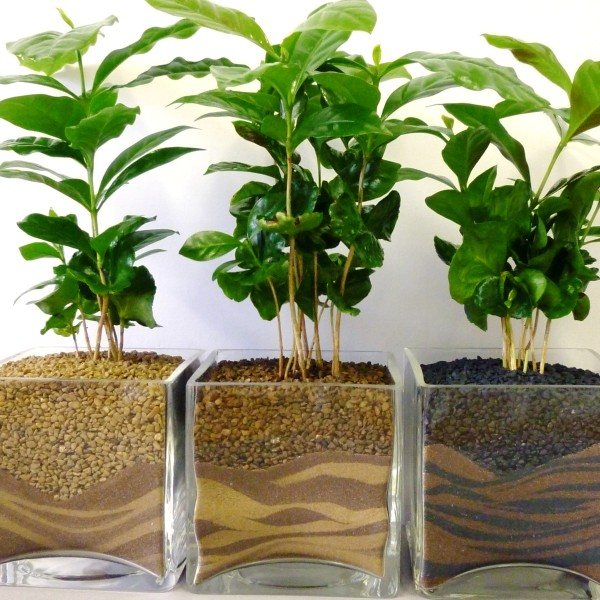

Photo gallery
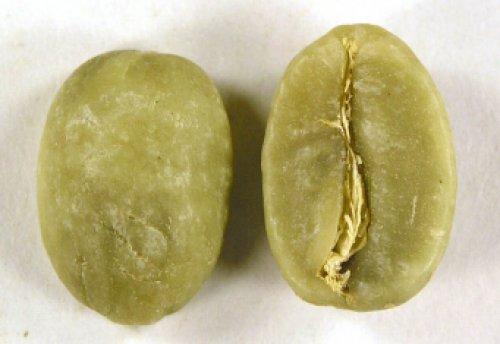

Coffee seed
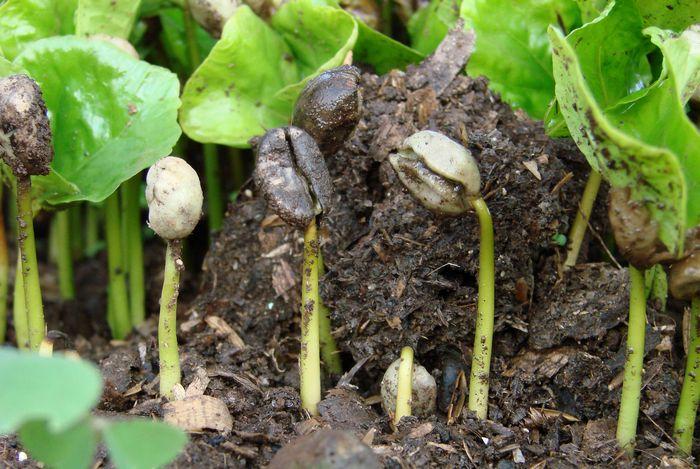

Sprouted coffee beans
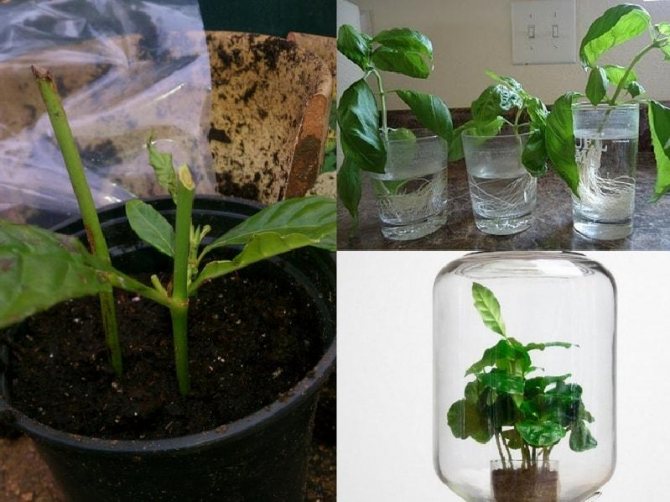

Cutting coffee
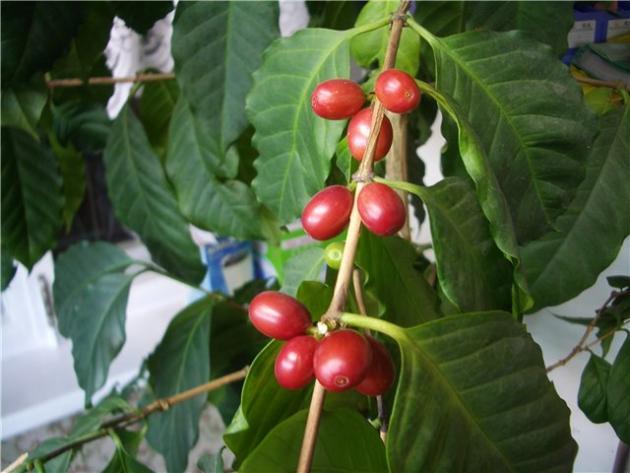

Coffee tree fruit
Top dressing
The coffee tree blooms intensively and bears fruit, therefore it needs enhanced nutrition. It is best to buy a complex fertilizer. The universal organic fertilizer "Miracle of Fertility Sapropel" is well suited for feeding the coffee tree, as well as fertilizers for indoor flowers based on chicken manure.During the flowering period, the tree can be watered 1-2 times with water infused with straw ash: it is rich in potassium.
Feeding schedule:
- from March to October - once every 2 weeks;
- from November to February - once a month.
If the leaves become dull, they are wiped with water and lemon juice (for 1 liter of water - 2-3 tsp. Juice). The plant is watered with the rest of the solution (but not more often than once a month).
Diseases and pests
All problems are directly related to improper care. This creates a favorable environment for the emergence and development of such ailments:
Rust
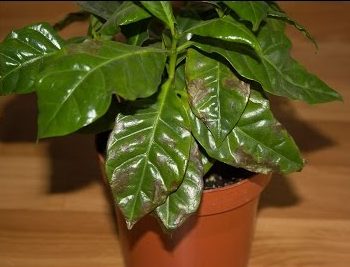

If a fungus is found, take urgent action and treat the plant
This dangerous disease is caused by a fungus. It can be diagnosed by spots of a characteristic color. It is not easy to treat, but success is guaranteed if all the rules are followed. Processing continues until the fungus disappears. Apply Bordeaux liquid.
The first signs of its appearance are uncharacteristic points on the surface of the leaf, resembling a tortoise shell. It feeds on green juice, which is why the culture quickly begins to wither, hurt and deform. They cannot be found on a healthy exotic. Their "prey" is weakened plants. The first aid for finding a “find” is complete isolation.
If the population of the colony is insignificant, then it is worth rinsing the leaves under warm water or a napkin dipped in soapy water. After the branches are dry, you can spray them with special chemicals.
Geranium is a particular danger in this regard. This intruder is most often the source of insects. If there is such a green "neighbor" near the coffee beauty, then it is worth conducting a preventive examination as often as possible. If you notice larvae or mature adults, it is best to use an insecticide. In this case, the mechanical method of purification does not work in this case.
If necessary, the procedure is repeated after 10 days, and so on until it is completely eliminated.
Transfer
If the root system has filled the flowerpot, then it’s time to replant the tree. A plant under 3 years old is transplanted every year. Then the transplant is carried out once every 2-3 years. The pot should be 5-6 cm larger than the previous one. If an adult plant bears fruit, then it should be transplanted immediately after harvest, before flowering (comes in about a month).
Drainage is laid at the bottom of the flowerpot: expanded clay, clay shards, shells of nuts or apricot pits. Pour 1–2 cm of river sand on top, and then a soil mixture prepared in advance.
The coffee tree is transplanted together with an earthen lump (transshipment). The root collar should be slightly raised above the soil level in the flowerpot. If subsequently the earth settles due to watering, exposing the upper part of the roots, a layer of rotted manure or weathered peat should be poured into the pot.
Features of seeds
A ripe berry consists of a pulp and two grains suitable for planting in the soil. The coffee plant is very demanding on the environment. Common varieties are used for planting:
- Maragodjeep;
- Abbisinka;
- Bourbon;
- Mundo-novo.
Maragodzhip has a distinctive feature. Among all types of coffee - its beans are "gigantic" in size. Suitable for planting in any soil. The peculiarity of the variety is to acquire a different aroma and taste when grown in different (in composition) soil.
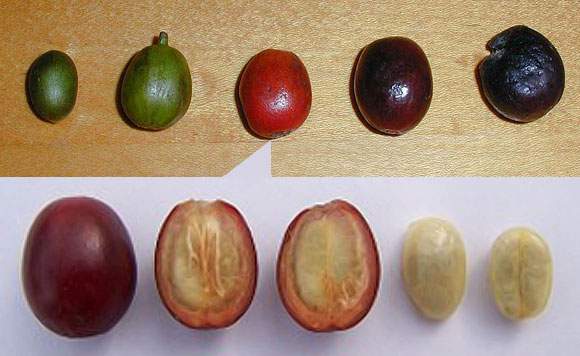

For all varieties, there is a certain natural condition - only a plant grown at an altitude of 1-2 kilometers above sea level bears fruit.
Pruning and shaping the crown
Seedlings of coffee trees are suitable for growing in standard form. Seedlings obtained from cuttings, over time, if you do not form a stem, turn into a dense spherical bush.
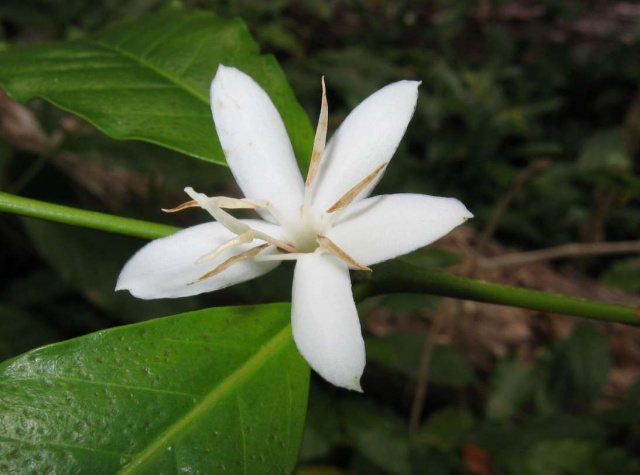

Flowering arabica coffee tree
In the first year, the shoot grows straight up, you do not need to pinch it.The tree begins to branch in the second year. If you want to form a stem with a dense crown, you can make a constriction:
- the operation is performed in late February - early March;
- when the central trunk grows to 25–30 cm, it is pulled tightly with a reinforced wire at a height of 15–20 cm, 1 cm below the internode;
- pinch the upper bud, if necessary - cut the shoot so that 2 internodes remain above the wire;
- subsequently, all branches above the constriction, growing upward, are cut off. The rest of the branches are trimmed to your liking so that the tree looks aesthetically pleasing;
- after 3-4 years the constriction is weakened, after a month - removed. As a result, with a tree height of 50 cm, the crown diameter can reach 1.5 m.
Care after purchase
So how to grow Arabica coffee at home? The coffee tree is famous for its unpretentiousness, but this does not mean at all that it does not need care and creation of the necessary conditions.
REFERENCE! The first thing to think about before buying is the presence in your apartment of the space that the tree needs. The fact is that Arabica can grow to the size of a two-meter bush.
Position the plant so that the sun's rays do not directly hit the leaves. Sun exposure can cause burns on delicate leaves. At the same time, Arabica loves bright lighting, it is desirable that it be a little diffused.
If there is a lack of natural light, phytolamps can be installed. This will create additional lighting. The most comfortable coffee will feel on the windows facing east or west.
ATTENTION! The homeland of Arabica is the tropical lands of Asia and Africa. It is there that this species grows wild.
The climate in Russia is not suitable for coffee, so attempts to create a plantation on your own farmstead will not achieve the expected result. Arabica will not survive the cold season.
Watering
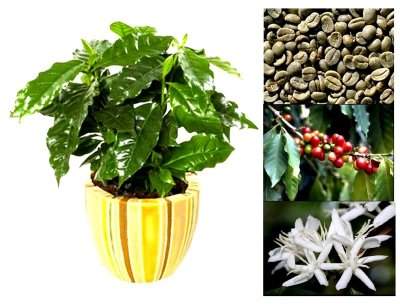

Arabica has an active period and a period when the plant goes into hibernation.
The active period falls on the warm part of the year, from about March to October. At this time, Arabica needs the soil to constantly maintain moisture and not dry out. During hibernation, water consumption decreases.
It is better to pre-settle water for irrigation or use filtered purified water.
REFERENCE! In an effort to maintain soil moisture, you cannot overdo it and create an artificial swamp. If you overdo it with moisture, then there is a danger of rotting of the root system.
Top dressing should be carried out during the active period. Fertilizer should be added to the irrigation water once a week.
ATTENTION! Fertilizer should not contain calcium.
In the cold season, there is a rest period. During this period, watering should be reduced. It should also be borne in mind that evaporation in winter is less intense than in summer.
REFERENCE! In addition to watering, Arabica needs constant spraying. For a plant, indoor air humidity is of great importance. It is especially important to spray the leaves during the heating season, when the air in the apartments becomes especially dry.
Bloom
The coffee blooms in a delicate white color. The delicate petals of the Arabica coffee flower are fragrant with a rich pleasant aroma. Typically, the Arabica coffee tree begins to bloom in its third or even fourth year of life.
Subsequently, the flowers give way to small, round, red fruits. If, upon reaching the specified period, flowers do not appear on the tree, then you need to check whether the plant is being cared for correctly.
ATTENTION! Proper lighting is essential for the flowering of the coffee tree. The lack of colors can be caused by a lack of light.
Below are photos of Arabica coffee, home care for it allows you to achieve the following results:
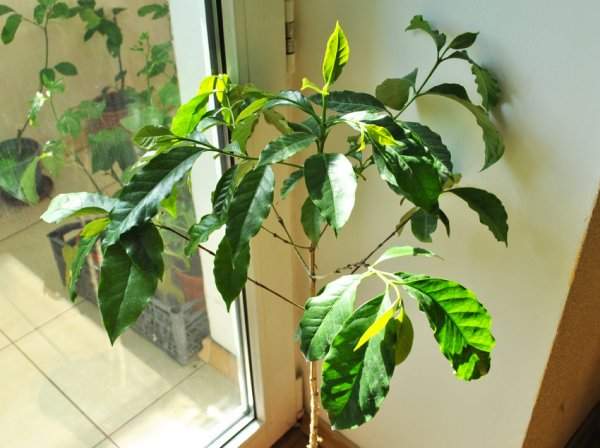

Priming
For Arabica, a slightly acidic soil will be most suitable.If it is not possible to purchase a ready-made coffee tree soil mixture, you can use a mixture for plants that also prefer acidic and slightly acidic soil. These plants include azalea or hydrangea.
REFERENCE! Before planting the coffee tree, make sure the selected pot is the right size. A thick drainage layer should be laid out on the bottom.
This is a prerequisite for all plants that need abundant watering. If the drainage layer is sufficient, then the water will not linger near the roots and create a risk of decay.
Transfer
Young coffee trees need to be replanted annually.
The best time of the year to transplant is Spring.
When the plant reaches a large size and stops growing, the need for regular replanting disappears.
It is enough to replace the top soil annually.
How to start a coffee tree at home
The best option for home is the Arabica coffee tree. Robusta, although less whimsical, needs cross-pollination, so it is more difficult to get it to bear fruit. If there is little space in the house, you can buy grains or sprouts of dwarf arabica, one of the most popular varieties is Albert.
There are 3 ways to get a coffee tree:
- sprout from a grain;
- grow a stalk;
- buy in the store.
Growing coffee trees from beans
Ordinary green coffee beans, intended for making a drink, are unsuitable for germination: they have been harvested for too long and, in addition, they are subjected to special processing.
Coffee beans harvested no more than 1–1.5 months ago are distinguished by the best germination. These seeds can be purchased from online stores.
But it is best to ask the owner of the coffee tree for a ripe berry. Nature itself has covered the coffee beans with juicy pulp, so there is no need to soak them.
The optimum temperature for germinating seeds is from +19 to +24 ° C.
Soil composition for sowing:
- 1 part peat;
- 1 part sand;
- 2 parts of turf land.
- The soil mixture must be prepared 2 weeks before sowing.
- Sowing berries:
- the soil in the pot must be moist;
- the berry is laid on its side (flat side down) in a hole about 1 cm deep, sprinkled with earth, which is lightly pressed;
- the flowerpot is covered with a jar and placed in a warm, bright place (but direct sunlight should not fall on it).
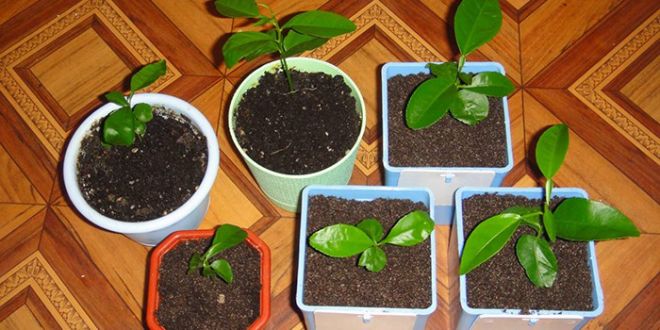

Berry germination will take a long time, about 3–6 months. But 2 sprouts can appear from the grains at once. They are kept under glass until the cotyledon leaves shed their hard shell. Condensation is periodically erased from the walls of the can. When the cotyledon leaves are straightened out, the plant gradually begins to accustom itself to the drier climate of the room.
Grains, freed from pulp, germinate somewhat faster (after 1–3 months).
Sowing a seed:
- The seeds are soaked for 30 minutes in a very weak solution of potassium permanganate, and then for another 30 minutes in aloe juice.
- The seeds are planted in the same way as the berries: in a hole 1 cm deep, flat side down.
- After planting, the soil is abundantly moistened, the flowerpot is covered with a jar.
Coffee trees grown from seeds bloom in 3-4 years.
Propagation of coffee trees by cuttings
For planting cuttings, a substrate is prepared in advance from peat and sand, taken in a 1: 1 ratio.
Planting the cuttings:
- A twig with 2 pairs of leaves is cut 2.5–3 cm below the bud. The cut should be oblique, it is treated with "Kornevin" or another rooting stimulant.
- The stalk is stuck vertically into a well-moistened ground so that the lower buds are covered with a substrate.
- The stalk is covered with a plastic bag, in which a small hole is cut. Periodically, through this hole, the cutting is sprayed with warm water.
A rooted stalk can only be replanted after a new pair of leaves appears.Coffee trees grown from cuttings bloom in the 2-3rd year.
Buying a coffee tree in a store
The coffee trees sold in the store usually look healthy in appearance: they have dark shiny leaves, often already have flowers or berries. But it should be remembered that purchased plants are often overfed with fertilizers.
Therefore, do not be surprised if at home the tree begins to turn yellow, shedding its leaves. With normal care, it will recover. The main thing is that there are no spider mites. Having brought the tree home, you need to quarantine it, separating it from other indoor plants. If a spider mite is found, the coffee tree must be treated with an insecticide. If the plant is healthy, transplant it.
Growing from cuttings
There are 2 methods for obtaining new shrubs: from seeds and cuttings. The best way to grow a coffee tree is by planting a cuttings. With this method, the plant will grow faster, flowering begins earlier, and the first fruit grains appear in 12-24 months. For seeds, this period will be 36–48 months.
The stalk takes root more easily, after rooting it will grow well in width, it is easier to form a crown on such a seedling. Landing is not time consuming and does not require special skills. After a few years, it will be possible to cut off the shoots from the ornamental plant for sale or propagation.
How to choose a seedling
Basic rules for choosing cuttings:
- carefully examine the plant for damage;
- the leaves should be bright green, there should be no spots, holes and dents;
- foliage is required on the trunk;
- check for pests and diseases.
For cultivation, as an ornamental plant, the Nana variety is suitable, which does not bear fruit, but has bright and rich buds. To obtain coffee beans, the Arabica variety is chosen: its spectacular appearance will also be a beautiful decoration for the home.
When buying a seedling in a store in winter, the plant must be insulated so that freezing does not occur on the street. To protect a young specimen, use paper or a plastic bag.
How to plant
In order for the coffee tree to take root, and to be able to harvest in the future, planting should be performed correctly:
- It is better to use a ready-made substrate for citrus plants as a soil.
- The pot is taken small: for the first planting (12 by 8 cm).
- Drainage is poured at the bottom of the flowerpot (pebbles, pebbles, rubble, broken brick).
- The lower part of the cuttings must be kept in a growth stimulator for 12 hours.
- The shoot is placed in moist soil.
- Cover (with a large jar, cellophane), create greenhouse conditions.
- They are placed in a warm (+ 22 ... + 25 ° С) and lighted area.
- Periodically open for ventilation, remove condensate from the lid.
- If necessary, watered and sprayed with settled water.
- After 3-4 weeks, new leaves will begin to grow, the plant is freed from greenhouse conditions.
Probable diseases of indoor coffee
Houseplant The coffee tree occasionally gets sick and is damaged by pests, but there are a few common problems with growing it. They are connected mainly with the lack of trace elements in the soil:
- With a lack of nitrogen, the plant develops slowly, new leaves are small, and the lower ones get a yellow color. With a similar dilemma, coffee should be fed with a substance of rotted slurry, which is diluted in a ratio of 1 to 15. It is also useful to spray it on the sheet with a substance of urea (1 g per liter of water).
- Lack of phosphorus is reflected in the fruit. They deform and fall off. Leaves can curl too. This is treated by introducing superphosphate, which dissolves in hot water.
- When there is not enough potassium in the soil, new leaves grow deformed, they can become covered with brown spots. You can try to add a solution of ash to the soil (1 tablespoon per liter of water).
Useful properties of coffee
It has diuretic properties, therefore it prevents the formation of kidney stones.
The benefits of coffee are used to prevent constipation. Vegetable fiber contained in grains helps in this. Caffeine increases the acidity of gastric juice and stimulates increased liver function and bile production.
Caffeine stimulates the nervous system, increasing efficiency, tones the body and eliminates drowsiness and headache. The effect lasts 3-4 hours.
The use of coffee for the respiratory system for bronchitis, pneumonia is to remove phlegm, due to the content of tannins. In combination with lemon and honey, it strengthens the immune system, suppresses viruses, and enhances the antioxidant effect.
A drink without sugar is useful for the female body when losing weight. It promotes fat burning during exercise due to the increased tone and performance caused by the effects of caffeine.
The benefits of coffee for hypotension are known, as it increases blood pressure.
Because of its antioxidant content, coffee is a cancer prevention agent in women and men. Antioxidants protect the cell structure from free radicals.
The drink prevents Parkinson's disease, Alzheimer's due to stimulation of the central nervous system. Drinking coffee prevents the destruction of brain cells.
How is coffee good for you? Caffeine enhances the effect of medications such as Aspirin, Paracetamol, increasing the stress on the liver.
The drink helps with poisoning due to its antioxidant effect. Promotes the elimination of toxins from the body.
Moderate use of caffeine (up to 300 ml per day) restores damaged liver cells, preventing cirrhosis.
Spraying
Oddly enough, the tropical Arabica tree does not need a high level of humidity at all, but it gratefully accepts spraying its large, beautiful leaves. Only water for spraying needs to be taken by a degree - one and a half warmer than the surrounding air and, of course, it must be settled, not have any impurities.
It is not difficult to take care of the Arabica coffee tree, the main thing is not to forget to monitor the level of acidity of the soil - with a decrease in it, the leaves will begin to fade, turn yellow and dry. They will dry out even without fresh air, but the tree must be protected from drafts or directed air currents. Too high air humidity can provoke leaf decay, this should not be allowed. This tree also does not like to be cut and rearranged from place to place. Therefore, you need to think about the formation of the crown from the very beginning - it is better to pinch the sprout than to cut off the shoot later.
Scientific name
The coffee tree can be called simply Coffee for short. This type of plant belongs to the madder family. There are over 70 different types of coffee. The most famous types:
- Arabian, also called Arabica;
- Bengal;
- Robusta, or Congolese;
- Cameroonian;
- Liberian.
The following tree-like indoor plants are also grown at home: Ficuses "Eden", "Black Prince", "Bengal", "Kinki", Cypress "Goldcrest Wilma", Avocado, Lemons "Panderoza", "Pavlovsky", some types of ornamental conifers and others ... Many of them are suitable for making bonsai.
Noteworthy facts
Why pause your choice of Arabica coffee?
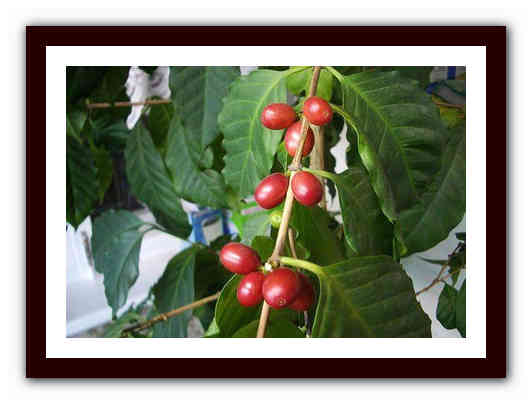

Here are some fun facts about this plant:
- Up to 500 g of greenish coffee beans are harvested from 1 home tree once a year.
- Historical background: the coffee tree has existed for about a thousand years. This plant became ornamental about 300-400 years ago.
- The flowering period takes only 2-3 days, and the ripening of the fruits takes six months.
- the caffeine in beans grown without the help of others is a couple of times higher than in coffee from the store.
- Arabica occupies about 70% of the global coffee plantations.
Although coffee is not yet so popular in home gardening, trying to grow it is definitely a great idea. For decorative purposes, the plant harmoniously fits into any interior. And without the help of others, grown coffee beans will be a good reason to gather relatives over a cup of fragrant drink.
Coffee plant - Arabica home care.
Coffee is a wonderful generous tree that can simply be grown at home. Its history begins in Africa, but they learned to cultivate it everywhere. You can grow a small coffee plantation in your home, this is not a joke at all. Home plant coffee is undemanding, it is enough to organize proper care and after a couple of years, coffee made with homemade grains will become a pleasant prize.
Growing a coffee seedling
What is needed for landing
Indoor trees - laurel, nolina or bottle tree, juniper
A coffee tree is grown in a special soil. They buy it in a store or prepare it yourself. The following components will be needed:
- sheet soil;
- peat;
- river sand;
- rotted manure.
Charcoal is mixed with grated moss. The pH of the substrate is 5.0-5.5. When spraying, it is possible to add a couple of droplets of vinegar to the water.
A young culture will have to be transplanted next year, an adult in 3 years. Next, the top soil layer is changed. The composition of the soil should be sour, fertile, rather light. It is responsible for aerating the root system and preventing water stagnation.
Optimal location
Ideal for positioning coffee tree windows on the west and east side of the house. In the summer season, the culture is taken out on the balcony, which is protected from wind and rain, as well as the burning sun.
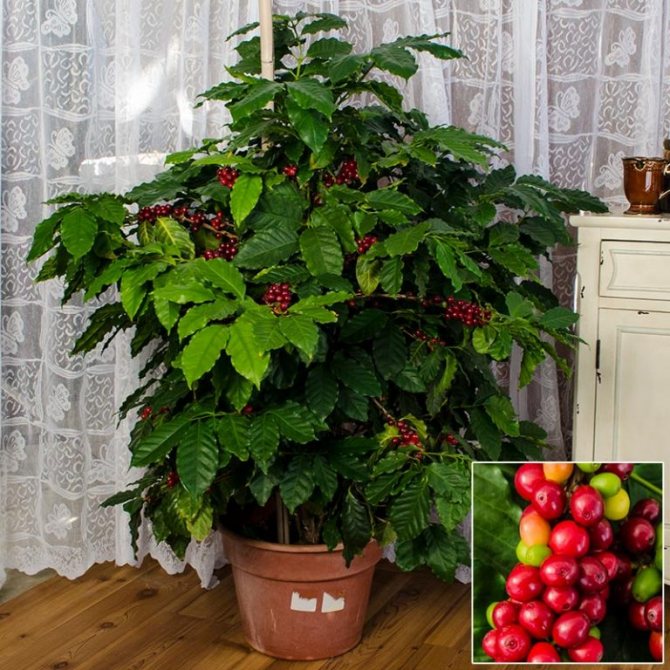

It is important to locate the plant
Frequent changes in the environment, which negatively affect fruiting, are not encouraged. If you want to get grains, the tree is not touched. Giving symmetry to the crown of coffee provokes crop loss.
Attention! Lack of ultraviolet light will negatively affect the growth of a houseplant.
When the plans are to rearrange the flower to another window sill, where there is more light, the following measures are taken:
- The bush is wrapped with gauze.
- The shelter is left for 2-4 weeks so that the culture gets used to the new environment and lighting.
- No burns after removing the gauze cover indicates approval of the new location.
Coffee is one of the plants that prefer solitude and dislike the crops in the neighborhood. A separate window sill fits the seedling.
Pot selection
The selection of the pot is determined by the central root of the coffee tree. The size of the container is at least 30% larger than the seedling for the plant to obtain useful elements in sufficient volume.
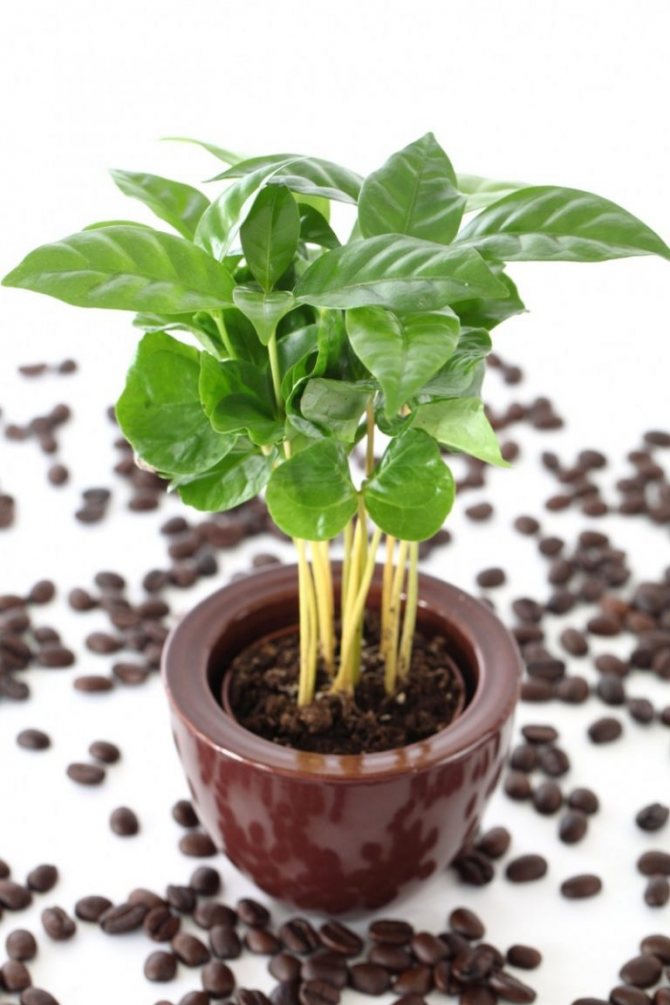

Choosing the Right Pot - Great Coffee Growth
To prevent moisture from stagnating, good drainage is required. Expanded clay or broken brick is placed at the bottom of the vessel.
When a plant is transplanted, the main thing is not to disturb the roots, to reload the coma, add soil to the sides and on top, and compact it slightly.
Grain preparation
It should be borne in mind that the seeds of an exotic coffee tree quickly lose their germination. That is why you need to start working with them right away.
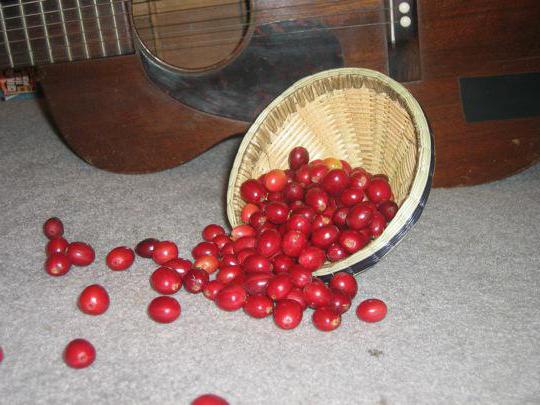

If coffee beans fall into your hands, they should be rinsed with water and placed in a pink solution of potassium permanganate for half an hour. This must be done to disinfect this material.
Natural growing conditions of coffee trees
Ethiopia is originally considered the birthplace of coffee trees. The first trees of this species appeared there, from which all other varieties of Arabica originated. The Arabian variety has a different name for Arabica. Another interesting fact that confirms that the first trees appeared in Ethiopia is that any local resident will easily drink 12 cups of the strongest drink and still feel great after so much caffeine.
If a European, whose previous generations were not related to the alkaloid and were not used to it, drinks so much coffee, he will definitely go to the hospital with poisoning.
There is one difference: the Ethiopians used grains for food, and the Arabs learned how to make a drink from them.
There is also the Congolese tree or robusta. His homeland is also Africa, but this time the Congo. This tree is more common, as it has a strong immunity to diseases and environmental conditions.
Suitable temperature, humidity and lighting for coffee
For the normal development of the seedling, it needs the following air temperature:
- Summer period - up to +22 degrees;
- Winter period - up to +18 degrees.
In winter, the temperature in the dwelling should not drop below +12 degrees, because if the temperature regime is lowered, the growth of a young green pet is inhibited and its roots rot. Not very comfortable conditions for overwintering are quite suitable for an adult plant. An acceptable temperature in the winter season for him is +10 degrees, good lighting is imperative, and a small rare watering of the root zone.
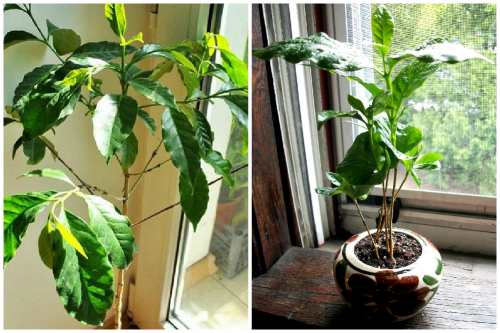

The seedling is very fond of when its leaves are regularly sprayed with settled warm water. This procedure is carried out at all seasons. A homemade coffee tree should grow in moderately humid air. If it is dry or excessively wet, it oppresses the plant.
Seedling growth on the northern window will be long, flowering will be late, and fruiting will be delayed. Southern lighting also has its drawbacks. The leaves of the coffee tree can easily get sunburn, so the plant is slightly shaded during the summer season. To do this, a newspaper sheet is attached to the window glass with tape. The rays of the sun falling on the coffee, becoming diffused, do not burn the leaves.
If there is no good sunlight, then an adult "green inhabitant" cannot form a full-fledged ovary. It is necessary not to miss the moment of the formation of fruit embryos by the flower brush, after this process the plant must be shaded.
How to choose the right seedling?
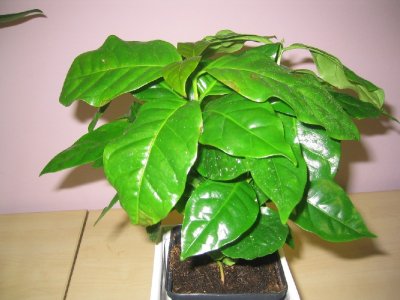

Where to begin? The most real thing is a trip to the store. You will be offered a great variety of copies. Do not hurry. The choice and purchase of a coffee seedling is a responsible business.
- Take a good look at the appearance of the plant:
- the color of the leaves should be bright green, without damage or spots;
- there should be a lot of leaves on the plant;
- no signs of disease and insects.
- Read the label with the variety name carefully:
- C.arabica- a real coffee tree, and it is grown as an indoor plant;
- nana - smaller, but more willing to bloom. More descriptive.
- For transportation in cold weather or windy weather, pack the seedling well so as not to damage it on the way home.
Characteristics of the coffee tree
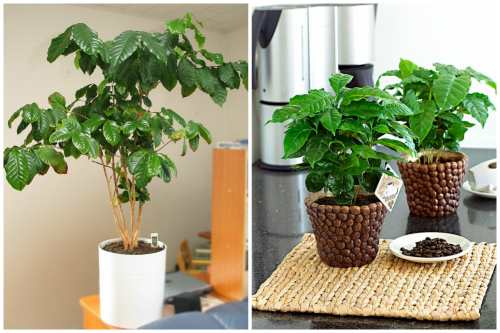

The homeland of coffee is hot Africa, specifically Ethiopia. All the species known to date have gone from there. But out of 50 varieties for indoor decorative cultivation, only one is suitable - it has the name Arabian. Its main differences are wavy, elongated oval-shaped leaves with a rich green tint and a pointed tip. The flowers are white, formed into a bunch, then turn into greenish berries, which become reddish when ripe. From these fruits, grains are collected, which are then turned into a well-known drink.
Flowering period and obtaining coffee beans
We hope that the article was useful for you, share it with your friends in social media. networks. Have a nice day! Until!
How to grow and care for a coffee tree at home.
It is difficult to find real high-quality coffee in ordinary stores today, and even if it does come across, it is very expensive. In similar cases, one way out is imposed: to grow coffee yourself.And although this activity requires an investment of energy and a long wait, a half kilogram of selected seeds collected from 1 tree at home will be the best merit for lovers of this fragrant and invigorating drink.
The benefits and harms of coffee
Coffee is a wonderful, invigorating drink. It is wonderful to wake up in the morning to feel its enchanting aroma.
What is the harm from coffee?
The debate about what is more beneficial or harmful in coffee has been going on since they first learned about it. Some argue that coffee excites, increases muscle tone, stimulates physical activity, clarifies thoughts, and improves mood. And the list goes on and on.
Opponents of coffee claim that it increases blood pressure and cholesterol. However, it has been proven that if the brewed drink is passed through a paper filter or napkin, the coffee becomes safe. A paper filter removes kahweol and kafestol from the drink, substances that increase blood cholesterol levels. Harmful or healthy coffee, everyone decides for himself.
Important! If you decide to brew a cup of coffee from grown beans, remember that it will turn out much stronger, and there will be more caffeine in such a drink.
And as for the coffee tree in your home, we can safely say that you will only benefit from it.
What is the use of coffee?
The plant cleans the air well, saturates it with oxygen. Its beautiful view cheers you up, and inhaling the scent of flowers you can do aromatherapy.
Possible problems and solutions
When growing a coffee tree, there is a risk of various problems. To deal with them, it is important to establish the reasons.
Leaves turn yellow
This disorder is accompanied by a yellowing of the trunk and is considered a consequence of a bacterial infection.
Loss of shine
Leaves lose their shine due to lack of light. They can turn yellow and crumble prematurely.
See also
Growing and caring for an azalea at home after purchase
Falling foliage
This problem can be caused by replanting a crop with a complete change of soil. The tree does not tolerate the exposure of the root system.
Blackening of leaves
The appearance of black leaves is associated with a violation of the temperature regime. With the formation of a black border on the foliage, one can suspect the freezing of an earthen coma. Sooty fungus also becomes the cause of problems.
Brown rust
This disease is provoked by fungal microorganisms. In this case, the leaves are covered with large brown spots. To prevent the disease, the culture should be sprayed with fungicides.

